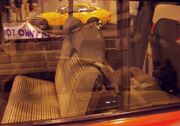 | |
| Manufacturer | Matra |
|---|---|
| Also called |
Matra-Simca Rancho (1977-1979) Talbot Matra Rancho (1980-1984) Matra-Simca Ranch (Italy) Talbot-Matra Ranch (Italy) |
| Production | 1977–1984 |
| Class | Leisure activity vehicle |
| Body style(s) | 3-door estate |
| Layout | FF layout |
| Engine(s) | 1.4 L Type 315 ohv I4 |
| Transmission(s) | 4-speed manual |
| Wheelbase | 2,520 mm (99 in)[1] |
| Length | 4,315 mm (169.9 in)[1] |
| Width | 1,665 mm (65.6 in)[1] |
| Height | 1,735 mm (68.3 in)[1] |
| Curb weight | 1,130 kg (2,500 lb)[1] |
| Fuel capacity | 60 L (15.9 US gal/13.2 imp gal)[1] |
| Related | Simca 1100 |
| Designer | Antonis Volanis |

The Rancho's optional third row of seats (making it an early MPV) shared head restraints with the normal rear seats
The Matra Rancho was a leisure activity vehicle created by the French engineering group Matra in cooperation with the automaker Simca to capitalize on the off-road trend, started by the Range Rover, by providing the "off-road look" at a lower price.
The Rancho was launched in 1977 and became a popular model, but this did not alleviate more wider problems at Chrysler Europe (Simca's parent company). Chrysler finally sold its European arm to PSA in 1978, following which it was rebranded as Talbot in 1979. The Matra-Simca Rancho now became the Talbot Matra Rancho and production continued until 1984 (although it remained on sale up to January 1985), reaching 57,792 cars in total.[2]
Designed by Antonis Volanis, the Rancho was based on the pick-up version of Simca's popular supermini, the Simca 1100, using its front structure and a stretched chassis. The rest of the body was made by Matra from fibreglass and polyester, including the mouldings adorning the body, which made it look more "sturdy". This technology would later be used on the Renault Espace, Europe's first MPV, which was manufactured by Matra. The ground clearance was also increased. Unlike most off-roaders, it was not fitted with all-wheel drive, retaining the 1100s front-wheel drive layout. Other elements retained from the 1100 included the dashboard and front seats (identical with the ones found in the Simca 1100 GLS). The Rancho was powered by the 1442 cc, 80 bhp version of the Simca Type 315 straight-4 engine.[2]
During its life, the Rancho was offered in several versions. Apart from the basic Rancho, there was the Grand Raid, fitted with such "off-road" extras as an electric winch on the front bumper and the spare wheel mounted on the roof - as well as a limited-slip differential. The Rancho X was the upscale model, with additional standard items such as alloy wheels and metallic paint. The Découvrable model's rear cabin consisted of an open frame with roll-down fabric covers, which could serve as an "open" car during good weather. Finally, the Rancho AS was the commercial version, with no rear seat, making it exempt from the French tax on passenger cars.[2]
The vehicle that Matra proposed to PSA as a replacement for the Rancho (which had been available with two extra, rear-facing seats) was a "monospace" (single box shape) concept, with flexible seating, which was ultimately rejected by Talbot's parent company. However, Matra managed to sell it to Renault and it became the Renault Espace.
References[]
| This page uses some content from Wikipedia. The original article was at Matra Rancho. The list of authors can be seen in the page history. As with Tractor & Construction Plant Wiki, the text of Wikipedia is available under the Creative Commons by Attribution License and/or GNU Free Documentation License. Please check page history for when the original article was copied to Wikia |